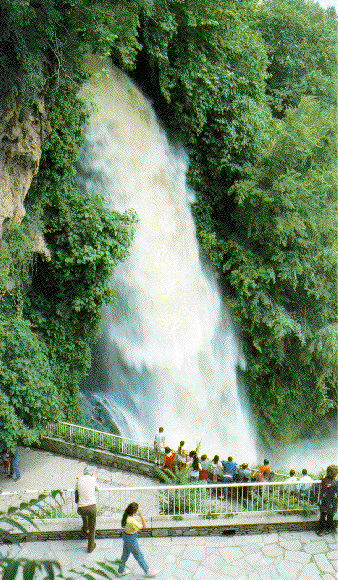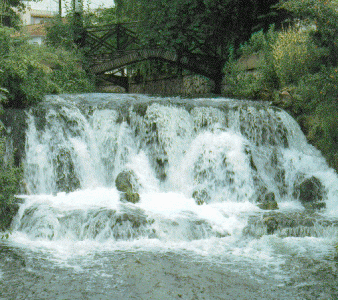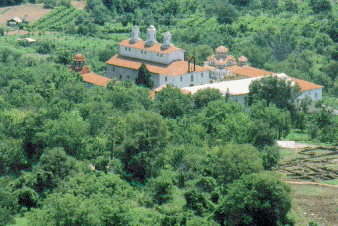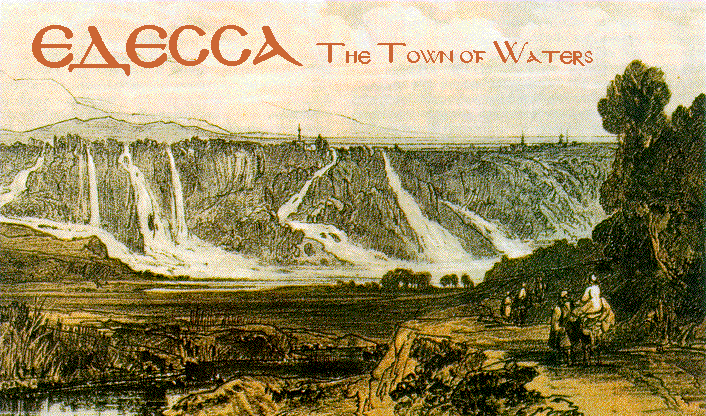 The main Edessa waterfall
The main Edessa waterfall
 The 'small waterfalls' within the town
The 'small waterfalls' within the town
 The Holy Trinity monastery
The Holy Trinity monastery
Places to visit
The Waterfalls Park
The Little Waterfalls square
The Varosi district, including
.... Parthenagogio
.... The Assumption of Virgin Mary church
.... The St. Peter and Paul church
The St. Metropolis Headquarters
The Holy Trinity monastery
The Lower Town remains
The Jeni Tzami
The FOE restaurant
Visit by car:
The old Pella remains
The Kaymakchalan winter complex
The Pozar spas
The Vegoritis lake and ..
.... a fish restaurant in Arnissa
The open summer disco's nearby
References
Most of the historic materials included in this page originate from the book "Edessa - the Town of Waters", written by Mrs. Rula Palanta and published by the Edessa Municipality and the Kastaniotis Publishing House. The photos are by Mr. G. Glynos, while the head picture is based on a 19th century lithography.
kritidis@cyclades.nrcps.ariadne-t.gr
ERL, INT-RP, NRCPS "Demokritos"
|
Edessa waterfalls
The beautiful Waterfalls Park is located in the edge of the precipice, crossed by the two principal Vodas branches. The visitor faces, from a 200 m elevation, the remains of the Lower Town archeological site, the nearby Holy Trinity monastery and further - the all green village of Rizari and the town of Skydra.
A number of good restaurants surround the Waterfalls Park, while the largest hotel of the town - Megas Alexandros - is 1 min walk away. A picturesque market of local popular arts is there too. Just behind one can see the remains of the Ano Estia spinning factory, which will be renovated and included in the park group. As for the waterfalls, one can step 20 meters down to observe the main waterfall from its southern side and even walk behind the water column, following the footpath to a small cave. The park hosts some of the oldest plane-trees of the town.
Looking to the left side of the park, one can see a beautiful forest surrounding the open municipality theater and the famous FOE restaurant, built by the Edessean Nature Lovers Society. It is a nice experience to attend, under the shining stars, a folklore concert in the amphitheater and to walk after that to the nearby FOE restaurant for a drink in its large open terraces facing the town and the Longos valley.
The right side of the park borders with the small Varosi district - a preserved region of old buildings, including the Parthenagogio (female school) built in 1877, the 14th century Byzantine Assumption of the Virgin Mary church and a number of small private churches (parekklisia) incorporated in the houses of well-off people of the past.
The beauties of Edessa
are not restricted to the waterfalls region. A short walk along the main Vodas branch brings us to the center of the town, where the new 25th March park has been built in the place of the old Gymnasion (high school). The park is full of interesting, sometimes even exotic trees, surrounding a nice cafeteria and several small bridges over the local Vodas branch. The fully-covered by tree coronas 18 October street leads to the coquettish old Edessa railway station, almost drowned under large age-old plane-trees.
Another plane-tree site is the Platanakia square - the former market place of Edessa. On the way there one passes near the Small Waterfalls Square, with nice new and old small bridges - a beloved meeting place of the teenagers before visiting the nearby pubs. From Platanakia one can follow the local Vodas branch to reach the Rock place - the most southern part of the Edessa precipice, with a terrace restaurant providing a different view to the southern surroundings of the town.
A short historical timetable
| -12 c. | Herodotus and Thukidides mention the presence of Phrygians in the region before the Dorian-Macedonians. The phrygian word 'vedu' (water) is considered to be related to the name of the town. |
| -11 c. | The arrival of Macedonians (Mahedni or Maketes) - a Greek Dorian tribe. |
| -9 c. | Perdikas or Karanos (king) founds the Argeades / Timenides Macedonian dynasty. |
| -4, -3 c. | The first fortification of the town. |
| -2 c. | The Roman historian Polybius provides the oldest reference to Edessa known so far. |
| -148 | Edessa becomes a Roman province. |
| -100 | The famous Egnatia Road passes close to the town. |
| 600 | The Lower Town in Longos is abandoned as a result of frequent incursions of Slavs and other tribes. The population moves to the Upper Town, where the modern Edessa is located. |
| 7 - 9 c. | The rural regions are destroyed by many incursions. |
| 976-1014 | The region becomes a part of the Bulgarian Kingdom of Samouil. The Slavic name 'Voden' means again 'water town'. |
| 1014 | The emperor Vasilios Voulgaroktonos restores the Byzantine power over the region. |
| 1024 | Macedonia becomes a part of the Thessaloniki Kingdom under the Latin Bonifacius, after the 4th Crusade. |
| 1261 | The Byzantine Empire is restored by the Paleologs. Macedonia is again the core of the new smaller empire. |
| 1351-67 | After prolonged war between the Serbs (Stephan Dushan) and Byzantium (Ioannis Katakouzinos), Pella, together with a large part of Macedonia and Albania becomes a Serbia province. |
| 1387-89 | The Turk general Alan seize the town after 8 months of resistance. The town is exposed to massive massacre and demolition. Edessa follows the fate of the central and southern Balkans - it enters the Black Hole of Balkan civilization. |
| End of 18 c. | Ali Pasha of Ioannina includes Edessa into its rebel kingdom. |
| 1822 | The Ottoman control is restored. |
| 1821-25 | 450 fighters under Angelis Gatsos participate in the liberation war of Greeks. |
| 1872 | The Bulgarian Exarchate (1970) is declared as schismatic by the Oecumenical Patriarchate |
| 1896 | A transitory cultural presence of Serbs |
| 1903 | The Macedonian Committee is formed in Athens by Dragoumis and Kalapothakis |
| 1903 | The Ilinden insurrection is bloodly crushed by the Turks |
| 1904 | A Macedonian Defence Fight committee is established in Edessa. |
| 1906 | Captain Agras is hanged in Vladovo (currently Agras) |
| 1912 | Greece, Serbia, Bulgaria and Cherna Gora proclaim a war to Turkey |
| 12.10.1912 | Edessa becomes again a part of Greece. The muslims of Edessa are protected by the Greek population |
| 1919 | The first electricity supply and the first newspaper in the town - 'Edessa' |
| 1922 | The Friends of Progress Society is established, the Edessa high school is built. |
| 1922-40 | Fast development of local industry units |
| 18.4.1941 | German occupation of the town. The 20-century Black Hole of the European civilization caused in Greece hundreds of thousands of victims and a totally destroyed and plundered economy |
|


 The main Edessa waterfall
The main Edessa waterfall
 The 'small waterfalls' within the town
The 'small waterfalls' within the town
 The Holy Trinity monastery
The Holy Trinity monastery